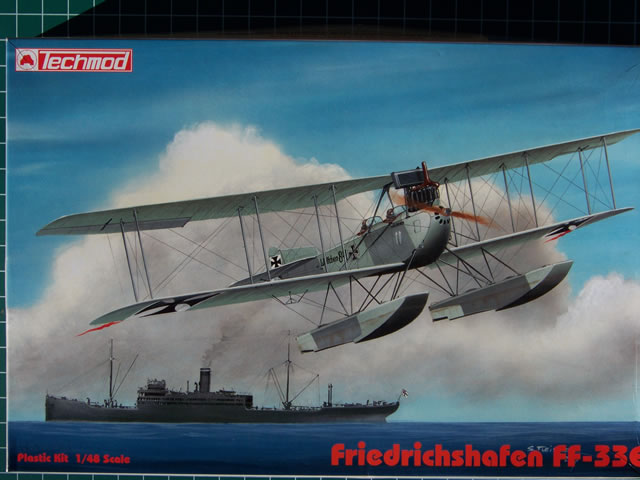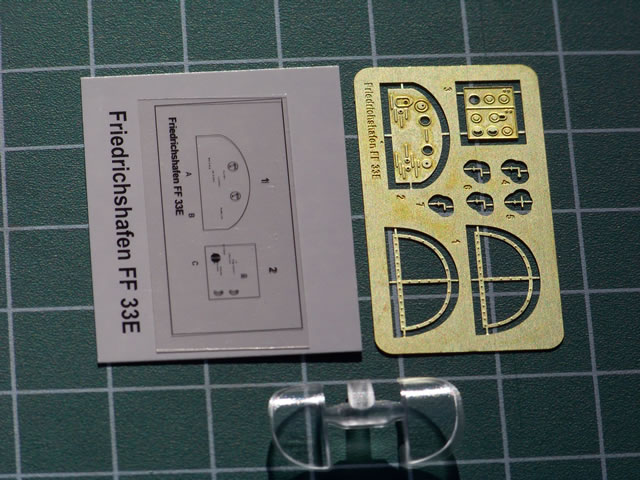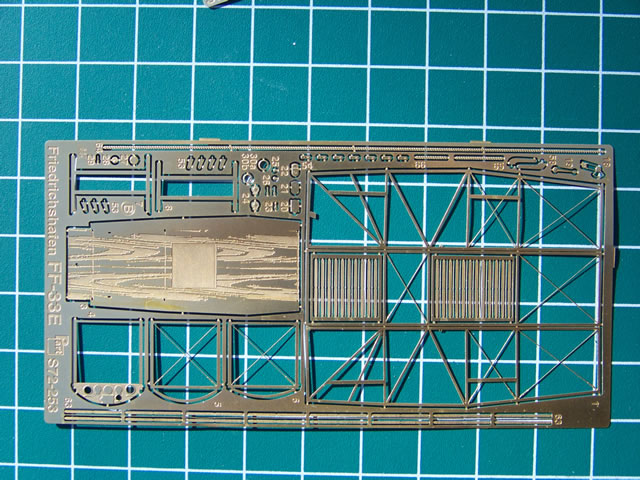Friedrichshafen FF-33E

Techmod, 1/48 scale
S u m m a r y : |
Catalogue Number: |
Techmod Kit No. 41101 - Friedrichshafen FF-33E |
Scale: |
1/48 |
Contents & Media |
Injected plastic, some photo-etch and film for instrument panel |
Price: |
Available online from Hannants for £23.57 |
Review Type: |
First Look |
Advantages: |
Dimensionally accurate, excellent surface details, thin trailing edges on wings, separate control surfaces, thin struts and prop, nicely detailed Benz engine. |
Disadvantages: |
Some sink marks & knock-out pin marks in hard-to-fill locations, seats need replacing |
Conclusions: |
Accurate and well-detailed, this is a great kit of the Friedrichshafen FF-33E |
Reviewed by Mike Dobrzelecki

HyperScale is proudly supported by Squadron.com
When I was a carefree bachelor in my twenties living in a carriage house in trendy Montclair, New Jersey, one of my favorite things to do on a Saturday morning was to walk down Bloomfield Avenue, the main drag through town, and hit all the old used bookstores and antique shops - the former for great buys on unusual books and magazines - the latter for military memorabilia. On one of the side streets was an establishment called the “The Antiquarian Book Shop”, which was owned by a grizzled old fellow who wore the same old ratty tweed jacket everyday. Old blues tunes wafted through the store from 78 rpm platters spinning on an old record player along with the cigar smoke from the short stogie sticking out of his “Popeye-like” puss – he was quite a character.

On one of my Saturday jaunts, I spied an interesting volume in black, entitled “The Cruise of the Raider Wolf”, by Roy Alexander, Yale University Press, New Haven, CT., published in 1939. It told the story of the German commerce raider,”Wolf” (or, more properly, Hilfskreuzer, SMS Wolf), a WWI “Q-Ship” converted from a Hansa line freighter, the Wachtfels, of 5,809GRT. She was modified with hideaway weaponry, including six 15cm guns, three 5.2 cm guns, several smaller caliber weapons, torpedo tubes, a compliment of 465 mines and, unique in the annals of WWI raider legend, a Friedrichshafen FF-33E twin float scouting seaplane, affectionately named, “Wolfchen” or, “Wolf Pup” in English. I had previously purchased a tome on another German raider, “Count Von Luckner – The Sea Devil”, written by none other than famed newsreel auteur, Lowell Thomas, and was looking forward to a great read – and what a cracking good story it was! In a 451 day epic combat cruise the Wolf, under the command of Captain Karl August Nerger, sank 35 merchant vessels and 2 warships, totaling 110,000tons and managed to return to Germany along a substantial cargo of critical strategic war material captured from the enemy vessels.
The “Wolfchen was an Friedrichshafen FF-33E HFt (Funkeinrichtung Zum Geben und Empfangen), the latter of which identified her as carrying an “Ft” radio set capable of both sending and receiving signals, although in the case of the “Wolfchen”, her radio did not work very well, so her crew removed it during her service with the raider. This FF-33E seaplane, No.841, the last in a series (829-841) of “E”models, played a significant role in the success of the raider, nevertheless. Flown by Flugmeister Leutnant zur See Stein and crewed by observer, Vizeflugmeister Fabeck on numerous hair-raising missions on no less than 3 oceans, the “Wolfchen” dropped hand grenades and small bombs on the decks of enemy vessels to halt their passage until the slow-moving “Wolf” could close on her victim. When No. 841 sustained damage on several occasions in the ocean swells, her resourceful crewmen scrounged materials from the “Wolf” and her victims, scavenging ship’s rails for wing struts and sections of tea chests, cigar boxes and just anything deemed useful to keep her flying. Truly, she was an historic aircraft in every aspect of the term.
So it was with some excitement and glee to learn that the Polish firm, Techmod, long known for their excellent decals and a limited selection of 1/35th scale AFV Kits and resin upgrades, had decided to get into the Injected aircraft model kit market, and chose as its first subject a 1/48th scale kit of the Friedrichshafen floatplane, and, in its first issue, the markings of the famed “Wolfchen”, HFT model No.841 Other kit issues, or separate after-market decal sheets, including one with Polish Navy markings, are rumored to follow from Techmod. The Poles captured several Friedrichshafen seaplanes, including an FF-33E (No.8), an FF-49B (No.1) and an FF-33L (No.9). The FF-33E flew in two different markings schemes, “White 8”, which sported a Polish Navy Battle Ensign flag painted on it and “Black 8”, which had no Polish flag, but had a black (or dark gray) nose and set of floats.
.
The Box Art
The striking box art depicts the Wolfchen flying from left to right in a front 3–quarter view, just above the viewer’s head, as if it just lifted off from the water, or, more simply, is performing a fly-by. Resplendent in its pale blue paint scheme and Maltese crosses, you could just about hear the angry whine of its Benz 150h.p. motor. The water line marine life smudging on the floats are a nice touch, too (mental note made for finishing the model). The aircraft’s name appears in large black letters on the fuselage side and in smaller letters below the observer’s cockpit (nice catch Techmod!). In the background the SMS Wolf can be seen either, at anchor or just making headway, a faint plume of smoke drifting from her funnel.
Instruction Sheets
The 8 page dual Polish-English language instruction sheet is rendered in full color and includes a workman-like potted history of the FF-33E, parts map, color key guide using FS numbers and Humbrol paint references, easy to follow exploded view assembly instructions, color profiles, decal placement guide, alignment guides and rigging diagrams. There is very little text instruction, but the assembly steps are well laid out and the use of full color, as seen on the latest Eduard and Mirage Hobby instructions sheets, really goes a long way in visualizing the completed model as it progresses. Modelers should pay attention to details, like adding piping from 5mm wire to the radiator, cutting off one of the projections from a pair of struts, wing incidence and float alignment notes and other construction tips in separate panels on the sheets.
The Kit
The kit consists of 92 gray injected parts on 4 major sprues, A, B, C & D, and one separate part on a cut-off sprue, 2 injected windscreens on 1 clear sprue, E, 1 sheet of photo-etch “F” for the instrument panel, , radio and windscreen frames, 1 clear film “G” for instrument panel and radio and a sheet of white card stock “H” with some extra instrument panel background printed on it.
Accuracy
The kit’s overall dimensions measure out well against the drawings in Windsock Datafile with any deviations to miniscule to mention. There has been much discussion on other internet sites about the kit’s dimensions, but that is most likely due to a lack of understanding about the differences between models of the FF-33’s. The shape of kit’s cockpit openings does differ from that depicted in the Datafile, however. The kit’s openings are roughly square-shaped with rounded corners, while the drawings depict them as more circular in shape. After studying photos of the “Wolfchen”, I think that Techmod got it right, at least for this specific aircraft (or series of “E” model aircraft), as the bottom edge of the openings are flatter than the drawings. This does not mean that Datafile drawings are wrong, since there does seem to be wide variation in fit and finish of individual FF-33’s.
Engineering and Kit Parts
The kit layout is very conventional, with two halves of the fuselage and separate left and
right upper and lower wings. The skin of the FF-33 kit is smooth exhibiting none of the slightly granular finish seen on Mirage Hobby aircraft kits, like their PZL P11.c, for instance. The surface detail on the fuselage is very nice, especially the subtle stringers on the upper fuselage behind the crew’s cockpit and frame locations along the fuselage sides. These will respond nicely to highlighting with washes and dry-brushing, as will the crisp sharp edges of the fuselage lines. The thin-edged cockpit openings are very nice.
The fuselage halves feature some fine interior framing detail, but the heavy knock-out pin marks may prove troublesome to correct, but perhaps the busy kit cockpit parts will cover most of this. Placement of the cockpit parts will benefit from the rectangular locating stubs and shelves on the fuselage interior, but this comes at a cost. These stubs, shelves and the locating pins and holes also cause some minor sinkholes on various parts of the exterior of the fuselage, though nothing a little filler and easy sanding won’t fix. Two noses are provided with the kit – one with no cooling slots that was part of Sprue B, and another with cooling holes that was the separate cut-off sprue in my kit, although this may come separated from Sprue B during shipment. The nose panel with the slots should be used for the “Wolfchen”. The windscreens are wonderfully clear and it will be tricky to paint both sides of the photo-etch framing and install them on the clear parts.

The cockpit includes a floor, a couple of seats, a large cylindrical fuel tank, bulkheads multi-part instrument panel, control wheel & column (no rudder bar), and radio. The seats are the only weak point of the interior, being too thick and clunky. The Polish firm, PART has released a photo-etch set, which provides nice thin replacements, along with a myriad of other parts (see end of this review for information on the PART PE set). A cable reel mounted on the outside of the fuselage is included in the kit. After test fitting the fuselage halves together along with the nose piece, it is clear that care will have to taken in mating these thin-edged pieces, perhaps best accomplished by gluing the top seam first, then the bottom of the fuselage, followed by each separate line of the nose panel where it meets the fuselage. From all indications such care will result in a great looking assembly replicating the sharp edged panel mating surfaces of the original.
The 150hp Benz Bz III motor is exquisite. It consists of 27 individual parts, including the ‘Imperial’ prop and the exhaust stack. There are some sink marks on the engine parts, but nothing that a quick fill and sand won’t cure. The 12 lifters are all separate individual parts and enough plumbing comes with the kit to make a really nice intricate engine. The exhaust stack is best left off until after installation of the wings and struts, since the stack pipes fit in between some of the struts.
The kit’s wings, fin and rudder are an absolute joy - wonderfully thin in section with very subtle rib and rib tape details and fine trailing edges. The control surfaces are separate parts and the cutouts on the wings include small rectangular stubs for hinges. I test fitted them and they are literally a “press-fit” - Outstanding, Techmod! The lower wing halves include a broad flat stub panel, which slots into a cutout on the underside of the fuselage, which should prove a sturdy assembly. Cleaning up the seams at this join will take a little effort, but, since it’s basically a flat area, it should not be too hard. The upper wings will be a little tricky to glue together and align, but that’s all part of building a WWI biplane. The rudder hinge bar is molded right into the part. The struts are thin to scale and nicely molded. A radiator is provided and it does feature some screen-like texture for the coils, but PE would be a better used for this part of the radiator.
The twin floats consist of a lower hull section with a detailed curved top plate to be added by the modeler. There are some sink holes on the top plates, which will prove hard to fill and sand, while not marring the detail on the circular inspection hatches and thin bars running the length the hull upper plates. Use of a masking tape guard on these areas should reduce the possibility of damage. The PART PE Set will also help to some degree with this issue, as they provide the circular inspection hatches. Sink marks also appear on the rear of the hull sides, but these are easily dealt with. The knock-out pin marks are noticeable on the underside of the hulls of the floats, too, but may disappear under a layer of paint. The float struts are also thin to scale and I hope that they will support the large floatplane model.
Painting & Markings
According to the Windsock Datafile No. 73, the kit’s decal sheet covers one bird, the aforementioned “Wolfchen”, as she appeared just upon her return to Kiel in 1918. If a modeler wishes to depict her in combat service with the “Wolf”, the FF-33E should carry no markings, at all, and I would guess that her appearance would be somewhat beat-up given the hard service she saw and multiple repairs affected by the crew of the “Wolf”. The only distinctive insignia on her during her combat career would be the Imperial German Battle Flag she flew from a starboard strut, 2nd in from the wing tip. This markings choice would make for a hell of model of the “Wolfchen” stowed and lashed on deck, ready for launching, some repairs evident on her airframe, crew and support personnel about her busy with getting her ready. About two weeks prior to her return to Germany, the ships’ crew repainted their oft-repaired FF-33E for show purposes back at home and it is this “show” scheme that is depicted in the kit’s markings.

Techmod managed to catch all of details correctly of the “show” scheme, including the thinly outlined fuselage Maltese cross and the additional small “Wolfchen” name under the forward cockpit. Personally, I like Techmod decals, which are thin, but usually opaque. Just remember to apply them with plenty of Micro-set or water, in order to provide a little wriggle room to maneuver them into final position, as their decals tend to stick where first placed.
The other colors used on the model are pretty straight forward. The cockpit consists mostly of wooden parts, as does the fuselage and prop, so wood tones will dominate the interior finish. The Techmod sheet shows that the rear of the fuselage should be finished in a linen fabric color. The Benz engine is finished in a variety of shades, which will really catch the viewer’s eye. Overall, the model, including floats, is to be finished in overall German Navy Pale Blue FS 35622, Humbrol HU122, although light gray is considered another possibility. Mister Kit WWI Paints would be nice alternative for the outer surfaces.
Aftermarket PART Photo-Etch Set |
The Techmod FF-33E can be finished as a fine model right the box. For those who can’t leave well enough alone, PART has released a great photo etch set No. S48-153, which includes everything you would need to super detail the kit.

Three separate photo etch sheets come in the package, along with a sheet of film for the instrument panel and windscreens. Of course, the interior gets the most attention and the PE fold-up seat is good replacement for the Techmod thick seats.

Parts are included to dress up the engine, prop, radio cable reel, control horns, rigging attachments hardware and turnbuckles, float inspection plates and radiator screen, the latter two, of which, will come in especially handy.
References
First and foremost, I highly recommend the Windsock Datafile No.73 on the FF-33E, by P.M.Grosz, Albatros Publications as a “must-have” reference to build the kit.
Other useful articles include:
“Friedrichshafen FF33 Series of the Polish Navy” by W.Butrycz, Windsock International Vol. 18 No.2 March/April 2002, Albatros Publications
“German Seaplanes in Poland” by W Sankowski, Windsock International Vol. 10 No.5 Sept/Oct 1994, Albatros Publications
“Polksie Lotnictwo Morskie 1920-56”, Kamponie Lotnicze No.19, by M.Konarski & A.Olejko, AJ Press, 1998, Poland
“Cruise of the Raider Wolf”, by Roy Alexander, Yale University Press, New Haven, CT., published in 1939.
Purchased by reviewer
Review Text Copyright © 2010 by Mike Dobrzelecki
Page Created 8 April, 2010
Last updated
8 April, 2010
Back to HyperScale Main Page
Back to Reviews Page

|
Home
| What's New |
Features |
Gallery |
Reviews |
Reference |
Forum |
Search